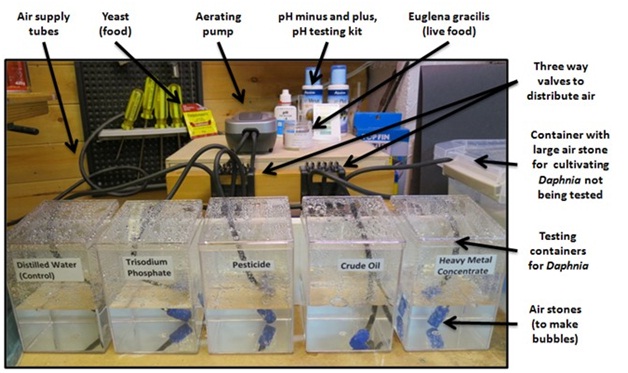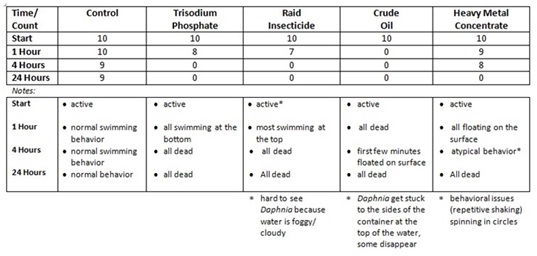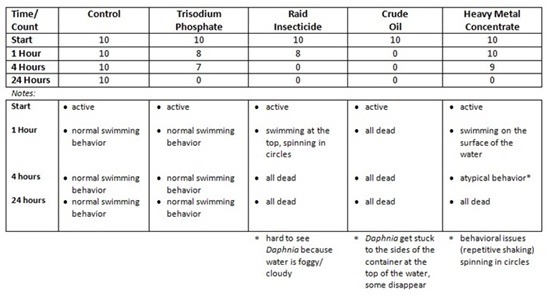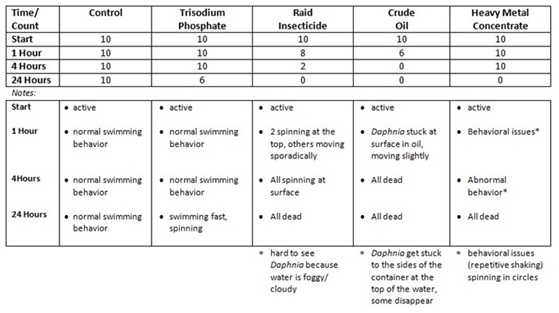





Published on Sep 12, 2023
During my experiment, I tested the toxicity of crude oil, heavy metal concentrate, pesticide, and trisodium phosphate using Daphnia (water fleas). These pollutants were tested for acute toxicity at 0.1%, 0.05%, and 0.02% concentrations. My experiment shows just how harmful the effects of marine pollutants are on aquatic life
The problem I would like to address is that chemicals and pollutants are spilled and dumped in the ocean every day, and this can severely affect aquatic life. Some of the major effects of marine pollutants are cancer, damage to organs and the immune system, reduced fertility, birth defects and death. This impacts the environment because of damage to the food chain, either through lack of food when marine creatures die, or when chemicals are passed along by being ingested by successively larger marine organisms and creatures.
If I change the type and concentration of a marine pollutant, how will this affect aquatic life; in particular, the behavior and longevity of Daphnia?
I predict that if the type and concentration of the marine pollutant is altered (exposing Daphnia to different pollutants and varying the concentration of the pollutants), and the duration of exposure to marine pollutants is increased (testing for acute exposure) then the number of living Daphnia will decrease or increase depending on the concentration and type of marine pollutant, and length of exposure. I think this will happen because different pollutants may have different effects on living organisms. I predict that crude oil will be the most toxic because, from reading about the effects of oil spills, I think it will be deadly at very low concentrations. The insecticide will probably be very toxic because it is meant to kill insects, and Daphnia (water fleas) are similar to the small insects. I also predict that the trisodium phosphate and zinc concentrate will not have as severe effects because the published warnings about these chemicals not as harsh as the others.
1. 500mL of distilled water put was in each aquatic container.
2. The pH was tested and increased/decreased as required.
3. The aerating system was set up (water stones, air pump, tubes & valves).
4. The temperature in the room was maintained at 20oC by using a heater.
5. The growing lights were set up and timed to be on for 12 hours per day.
1. The marine pollutants were precisely measured and put into the containers.
2. 10 Daphnia were put into each container using a pipette.
3. The Daphnia were counted and observed at 1 hour, 4 hour & 24 hour intervals.
4. The Daphnia were fed when needed.
5. This procedure was repeated for all concentrations for each marine pollutant.




The number of living Daphnia was decreased by different amounts depending on the type and concentration of marine pollutants in the water, and the duration of exposure to the pollutants. I discovered that crude oil was the most harmful. In order from most to least harmful, my results were:
1. Crude Oil
2. Insecticide
3. Zinc Concentrate
4. Trisodium Phosphate
The control (distilled water) did very well, with only one Daphnia dying throughout all the tests.
I started with 10 Daphnia in each container and the experiment spanned 24 hours every time it was performed at 0.1%, 0.05% and 0.02% concentrations. Overall, the results were similar except at lower concentrations the effect was not as immediate.
0.1% (1,000 parts per million) Concentration: The first time I performed the experiment, with a 0.1% concentration of the pollutants, the Daphnia in the crude oil were dead after one hour. At four hours, there were seven left in the insecticide, eight in the trisodium phosphate, and nine in the zinc concentrate. At twenty-four hours, only the Daphnia in the control container were alive.
0.05% (500 parts per million) Concentration: For the 0.05% concentration test, at one hour, the crude oil had no living Daphnia, the insecticide and trisodium phosphate had eight living, and all of the zinc concentrate Daphnia were alive. At four hours, the water fleas exposed to this concentration of insecticide and crude oil were all dead, the trisodium phosphate solution contained seven living bugs, and there were nine remaining in the zinc concentrate solution.
0.02% (200 parts per million) Concentration: At the one hour mark, for the 0.02% concentration, there were six alive in the crude oil, eight remaining in the insecticide, and all of them were alive and swimming in the trisodium phosphate and zinc concentrate solutions. At four hours, all of the Daphnia exposed to crude oil at this lowest concentration were dead, there were two water fleas swimming in the insecticide solution, and all of the Daphnia in the trisodium phosphate and zinc concentrate solutions were alive. At twenty-four hours, all of the Daphnia were dead except for six in the trisodium phosphate and all in the control.
The only exception was that there were more living Daphnia in the trisodium phosphate solution than in the zinc concentrate solution at the end of the 0.02% concentration test.
Although the trisodium phosphate and the zinc concentrate were the least harmful, they did appear to cause some damage to the water fleas' nervous system. I observed that the Daphnia would shake, spin, and move sporadically. This also happened to the Daphnia that were in the 0.2% pesticide solution. Overall, the marine pollutants either caused death or serious side effects. I believe that even the non-lethal side effects were likely serious enough to eventually kill the Daphnia, especially with longer term (chronic) exposure.
Therefore, the data supports my prediction and I accept my hypothesis. There are several reasons for this. First of all, when I put the Daphnia in the crude oil, after a few minutes they got stuck in the oil. The water fleas were immobilized and floated at the surface of the water. If I had used a larger organism, it might not have gotten stuck in the oil and survived longer. Another observation I made was that when I put the zinc concentrate into the container, it immediately sank to the bottom. This may have minimized the effect on the Daphnia, causing them to die more slowly, although enough zinc might have dissolved into the water to affect the Daphnia, or some of the more dangerous or toxic elements in the concentrate (such as lead, cadmium and arsenic) might have had an effect.
The insecticide was likely very toxic to the Daphnia because it is made to kill bugs. I also think that the effects of these chemical compounds may have been very severe on the Daphnia because of their miniscule size. With larger organisms the effects may not have been as harmful because the size of larger organisms should be able to help them withstand more of the pollutants. I think that the Daphnia died very quickly (an acute effect) because I was putting fairly high concentrations of pollutants in the water. These levels may be higher than what typically occurs in the real world when pollutants enter a marine environment, although my experiment may duplicate localized effects of marine pollutants before those pollutants get dispersed into the environment.
Today, ships spill and pipelines leak oil, we wash chemical compounds such as metal concentrates out of ship holds when the holds are cleaned after cargo unloading, insecticides get washed into water off yards and farmer's fields, and people put detergents down the drain. People pollute the world every day without even realizing it, making an effort to avoid doing so, or promptly cleaning up spills. This science experiment shows just how severe the effects of our carelessness are on aquatic life.
Water Treatment Plants: One way to utilize the results from this experiment is testing water cleanliness at water treatment plants. For example, it may be safe to have trisodium phosphate at a 0.02% concentration because almost all of the Daphnia lived, but not safe for insecticide at that concentration because none of the water fleas lived. The results of testing water quality with Daphnia could be used to determine if the water from the water treatment plants is safe to be put back into a lake or ocean.
Cohen, M. (2001). Analysis of Ordinal Dental Data. Jornal of Dental Research , 309-313.
Davenport, T. (n.d.). Top 10 Common Dental Problems . Retrieved October 22, 2012, from About.com: http://dentistry.about.com/od/toothmouthconditions/tp/10-Common-Dental-Problems.html
Elverne M Tonn, D. (2012, May 14). Tooth Plaque Causes, Preventions, and Treatements . Retrieved October 22, 2012, from WebMD: http://www.webmd.com/oral-health/guide/plaque-and-your-teeth
Periodontology, A. A. (n.d.). Types of Gum Diesease. Retrieved October 22, 2012, from Perio: http://perio.org/consumer/types-gum-disease.html